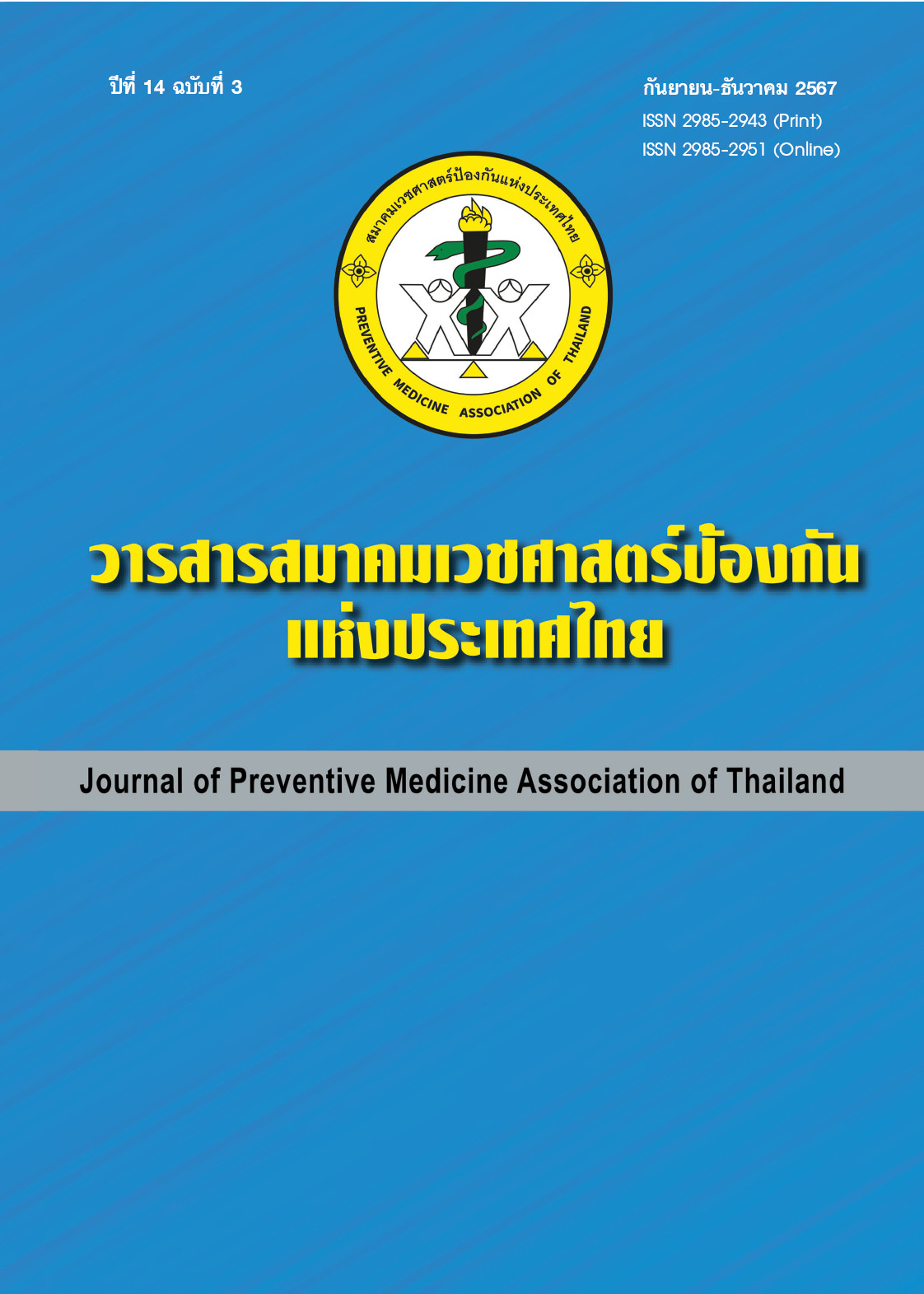Epidemiology and Associated Factors of Lower-Limbs Amputation of Diabetic Foot Ulcer in Banmi Hospital, Lopburi Province
Keywords:
epidemiology, diabetic foot ulcer, lower-limbs amputation, risk factorsAbstract
Objectives: To evaluate the epidemiology and associated factors of amputation in patients with diabetic foot ulcers at Banmi hospital. Methods: Retrospective descriptive study of 233 patients with diabetic foot ulcers from January 2020 to December 2023. Generalized characteristic, disease related characteristic, laboratory data were collected. The patients were divided into two groups based on their amputation surgery. To explore causes, levels, result, length of stay, direct cost and medical coverage of diabetic-related lower limbs amputations, the data were analyzed by using descriptive statistics and multiple logistic regression with statistic significant level at 0.05. Results: The total number of diabetic foot ulcers during 2020-2023 was 233 patients. Among them, 97 (41.63%) were amputated. The Most patients (38.1%) over than 60 years old. The most common cause was due to ischemic infection foot ulcers (50.5%). Toe amputation (87.6%) was the most common level of amputation. Length of stay was 13 days with direct cost of 17,426.50 THB. Most of them were paid by universal coverage. Factors related to diabetic foot ulcers amputation were history of previous amputation (OR=9.17, 95%CI= 3.755-22.415), leukocytosis (OR=5.21, 95%CI= 2.252-12.053), anemia (OR=8.42, 95%CI= 1.914-37.056), high blood sugar level (OR=5.87, 95%CI= 1.893- 18.170), high HbA1c level (OR=3.05, 95%CI= 1.092-8.530) and osteomyelitis (OR=25.05, 95%CI= 5.925-105.89), significantly. Conclusion: Diabetic foot ulcers are a major public health problem and are the main cause of lower- limbs amputation in diabetes patients. Therefore, establishing guidelines, early detection of diabetic foot ulcer through multidisciplinary care and knowledge of risk factors for amputation can be helpful and decreased rate of lower-limbs amputation.
References
Junrungsee S, Kosachunhanun N, Wongthanee A, Rerkasem K. History of foot ulcers increases mortality among patients with diabetes in Northern Thailand. Diabetic Med 2011;28(5):608-611.
Ogurtsova K, Fernandes JD, Huang Y, Linnenkamp U, Guariguata L, Cho NH, Canva D, et al. IDF Diabetes Atlas: Global estimates for the prevalence of diabetes for 2015 and 2040. Diabetes Res Clin Pract 2017;128:40–50.
กองโรคไม่ติดต่อ กรมควบคุมโรค. รายงานการพัฒนาคุณภาพการบริการในผู้ป่วยโรคเบาหวานและโรคความดันโลหิตสูงผ่านสื่ออิเล็กทรอนิกส์ (VDO Clip) “การให้ความรู้และสร้างทักษะเพื่อการดูแล โรคเบาหวานและความดันโลหิตสูงด้วยตนเอง” [อินเทอร์เน็ต]. 2564 [เข้าถึงเมื่อ 18 พ.ค. 2565]. เข้าถึงจาก: https://shorturl.at/NJeP2
Leelawattana R, Pratipanawatr T, Bunnag P, Kosachunhanun N, Suwanwalaikorn S, Krittiyawong S, at el. Thailand diabetes registry project: prevalence of vascular complications in long-standing type 2 diabetes. J Med Assoc Thai 2006;89(1):54-9.
World Health Organization. Diabetes [internet]. 2024 [cited 2024 Apr 1]. Available from: https://www.who.int/en/news-room/fact-sheets/detail/diabetes
McDermott K, Fang M, Boulton AJM, Selvin E, Hicks CW. Etiology, Epidemiology, and Disparities in the Burden of Diabetic Foot Ulcers. Diabetes Care 2023;46(1):209-21.
Lin C, Liu J, Sun H. Risk factors for lower extremity amputation in patients with diabetic foot ulcers: a meta-analysis. PloS One 2020;15(9):e0239236.
Moss SE, Klein R, Klein BEK. The prevalence and incidence of lower extremities amputation in a diabetic population. Arch Intern Med 1992;152(3):610-6.
Centers for Disease Control and Prevention. Diabetes Program – Data & Trend – Hospitalizations for Lower Extremity Conditions. Atlanta: Centers for Disease Control and Prevention; 2005.
Vichayanrat A, Lueseangdang L, Pitmana-aree S. Diabetic foot ulcer. Siriraj Hosp Gaz 1979;31:883-97.
วิลาวัณย์ ถิรภัทรพงศ์, กุลภา ศรีสวัสดิ์. การศึกษาระบาดวิทยาและค่าใช้จ่ายในการรักษาผู้ถูกตัดเท้าหรือขาเนื่องจากเบาหวาน ณ โรงพยาบาลศิริราช. วารสารเวชศาสตร์ฟื้นฟูไทย 2551;18(2):65-9.
Rerkasem K, Kosachunhanun N, Tongprasert S, Khwanngern K, Matanasarawoot K, Thongchai C, et al. The development and application of Diabetic Foot Protocol in Chiang Mai University Hospital with an Aim to reduce Lower Extremity Amputation in Thai Population: A Preliminary Communication. Int J Low Extrem Wounds 2007;6(1):18-21.
มัทนา สารีคำ, กุลนาถ มากบุญ. ผลการดูแลผู้ป่วยคลินิกเท้าเบาหวานในกลุ่มงานเวชกรรมฟื้นฟูโรงพยาบาลสระบุรี. วารสารวิจัยและพัฒนาระบบสุขภาพ 2064;14(3):246-59.
สถาบันวิจัยและประเมินเทคโนโลยีทางการแพทย์ กรมการแพทย์. แนวทางเวชปฏิบัติ: การป้องกันและดูแลรักษาผู้ป่วยเบาหวานที่มีภาวะแทรกซ้อนที่เท้า (Clinical Practice Guideline: Prevention and management of Diabetic Foot Complications). นนทบุรี: สถาบันวิจัยและประเมินเทคโนโลยีทางการแพทย์กรมการแพทย์ กระทรวงสาธารณสุข; 2556.
สำนักโรคไม่ติดต่อ กรมควบคุมโรค. แนวทางการตรวจคัดกรองและดูแลรักษาภาวะแทรกซ้อนที่เท้าในผู้ป่วยเบาหวาน. นนทบุรี: สำนักโรคไม่ติดต่อ กรมควบคุมโรค; 2558.
Reiber GE. Epidemiology of foot ulcers and amputations in the diabetic foot. The diabetic foot, 2001.
Lu Q, Wang J, Wei X, Wang G, Xu Y. Risk factors for major amputation in diabetic foot ulcer patients. Diabetes Metab Syndr Obes 2021;14:2019-27.
Downloads
Published
How to Cite
Issue
Section
License
Copyright (c) 2024 สมาคมเวชศาสตร์ป้องกันแห่งประเทศไทย

This work is licensed under a Creative Commons Attribution-NonCommercial-NoDerivatives 4.0 International License.
บทความที่ลงพิมพ์ในวารสารเวชศาสตร์ป้องกันแห่งประเทศไทย ถือเป็นผลงานวิชาการ งานวิจัย วิเคราะห์ วิจารณ์ เป็นความเห็นส่วนตัวของผู้นิพนธ์ กองบรรณาธิการไม่จำเป็นต้องเห็นด้วยเสมอไปและผู้นิพนธ์จะต้องรับผิดชอบต่อบทความของตนเอง






